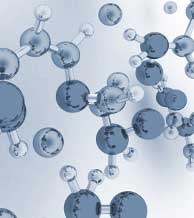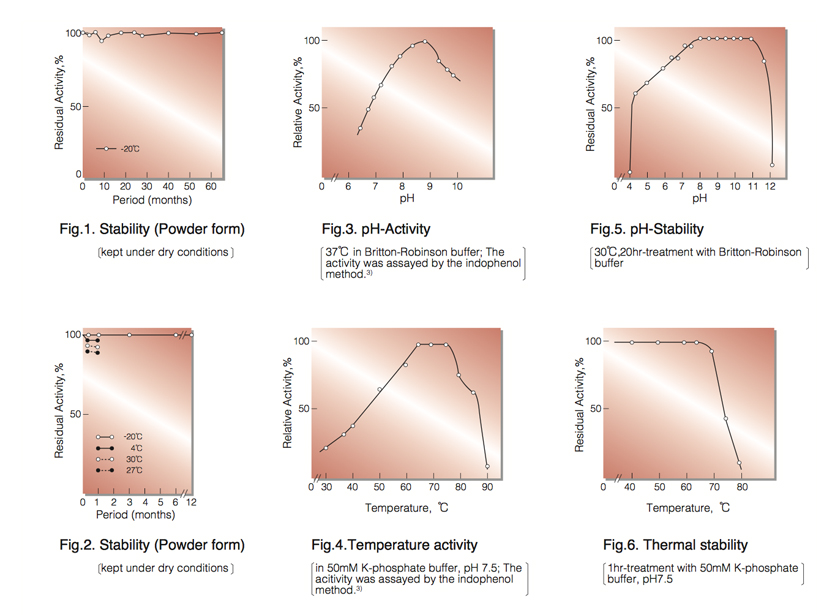CREATININE DEIMINASE from Microorganism
CNI-311
| Appearance: | White amorphous powder, lyophilized | |
|---|---|---|
| Activity: | GradeⅢ 10U/mg-solid or more (containing approx. 30% of stabilizer) |
|
| Contaminants: | Creatinine amidohydrolase ≤1.0×10⁻²% Creatine amidinohydrolase ≤1.0×10⁻²% Urease ≤1.0×10⁻²% NADH oxidase ≤1.0×10⁻²% NH4⁺ ≤1.0×10⁻²% µg/u |
|
| Stabilizer: | Mannitol | |
| Stability: | Stable at -20°C for at least One year (Fig.1) |
|---|---|
| Molecular weight: | approx. 260,000 |
| Isoelectric point: | 4.4 |
| Michaelis constant: | 3.5×10⁻³M (Creatinine) |
| Structure: | 6 subunits per enzyme molecule |
| Inhibitors: | Ag⁺, Hg⁺⁺, o-phenanthroline,monoiodoacetate |
| Optimum pH: | 8.5-9.5(Fig.3) |
| Optimum temperature: | 65-75℃(Fig.4) |
| pH Stability: | pH 7.0-11.0 (30℃, 20hr)(Fig.5) |
| Thermal stability: | below 65℃ (pH 7.5, 1hr)(Fig.6) |
| Effect of various chemicals: | (Table 1) |
APPLICATIONS
This enzyme is useful for enzymatic determination of creatinine when coupled with glutamate dehydrogenase (GTD-211, GTD-209, GTD-309) in clinical analysis.
ASSAY
Principle:
creatinine deiminase
Creatinine+H₂O+H⁺ ►N-Methylhydantoin+NH₄⁺
GIDH
NH₄⁺+α-Ketoglutarate+NADPH ►Glutamate+H₂O+NADP⁺
GIDH:Glutamate dehydrogenase(NADP⁺ dependent)[L-Glutamate:NADP oxidoreductase (deaminating), (EC 1.4.1.4.)]
The disappearance of NADPH is measured at 340nm by spectrophotometry.
Unit definition:
One unit causes the formation of one micromole of ammonia (the oxidation of micromole of NADPH) per minute under
the conditions described below.
Method:
| A. Creatinine solution: | 50mM (565.5mg creatinine/100ml of 50mM K-phosphate buffer, pH7.5) |
|---|---|
| B. NADPH solution: | 3.0mM (27.2mg NADPH・Na₄・4H₂O/10ml of 50mM K-phosphate buffer, pH 7.5)(Should be prepared fresh) |
| C. α-Ketoglutarate solution: | 10mM (14.6mg α-Ketoglutaric acid/10ml of 50mM K-phosphate buffer, pH 7.5)(Should be prepared fresh) |
| D. GIDH solution: | ca.1,000U/ml[Dilute Toyobo GradeII (Tris-HCl buffer solution, free from ammonia to ca.1,000U/ml with H₂O.)] |
| E. Enzyme diluent: | 50mM K-phosphate buffer, pH 7.5 |
Procedure
| Concentration in assay mixture | |
|---|---|
| K-Phosphate buffer | 49 mM |
| Creatinine | 38 mM |
| α-Ketoglutarate | 0.95mM |
| NADPH |
0.29mM |
| GIDH | ca.16 µ/ml |
1. Prepare the following reaction mixture in a cuvette (d=1.0cm) and equilibrate at 37℃ for about 5 minutes.
2.4 ml Substrate solution (A)
0.3ml NADPH solution (B)
0.3ml α-Ketoglutarate solution (C)
0.05ml GIDH solution (D)
2. Add 0.10ml of the enzyme solution* and mix by gentle inversion.
3. 2. Record the decrease in optical density at 340nm against water for 3〜4 minutes in a spectrophotometer
thermostated at 37°C, and calculate the ΔOD per minute from the initial linear portion of the curve (ΔOD test).
At the same time, measure the blank rate by using the same method as the test except that the enzyme diluent is added instead of the enzyme solution (ΔOD blank).
* Dissolve the enzyme preparation in ice-cold enzyme diluent (E) and dilute to 0.15−0.4U/ml with the same buffer, immediately before assay.
Calculation
Activity can be calculated by using the following formula :

ΔOD/min (ΔOD test−ΔOD blank ) × Vt × df
Volume activity (U/ml) = =ΔOD/min×5.06×df
6.22×1.0×Vs
Weight activity (U/mg) = (U/ml) × 1/C
- Vt
- : Total volume (3.15ml)
- Vs
- : Sample volume (0.10ml)
- 6.22
- : Millimolar extinction coefficient of NADH(㎠/micromole)
- 1.0
- : Light path length (cm)
- df
- : Dilution factor
- C
- : Enzyme concentration in dissolution (c mg/ml)
REFERENCES
- J.Szulmajster; Biochim.Biophys.Acta, 30, 154 (1958).
- T.Uwajima and O.Terada; Agr.Biol.Chem., 40, 1055 (1976).
- T.Uwajima and O.Terada; Agr.Biol.Chem., 41, 339 (1977).
- D.Tsuru; Rinsho Kensa, 22, 1331 (1978).
- T.W.Esders and S.Y.Lynn; J.Biol.Chem., 260, 3915 (1985).
| Chemical | Concn.(mM) | Residual activity(%) |
Chemical | Concn.(mM) | Residual activity(%) |
|---|---|---|---|---|---|
| None | − | 100 | MIA | 1.0 | 0.6 |
| Metal salt | 1.0 | NEM | 1.0 | 86.1 | |
| MgCl₂ |
103.8 | IAA | 1.0 | 60.1 | |
| CaCl₂ | 100.6 | Hydroxylamine | 1.0 | 86.1 | |
| Ba(OAc)₂ | 105.7 |
EDTA | 2.0 | 96.2 | |
| FeCl₃ | 5.0 | o-Phenanthroline |
1.0 | 0.7 | |
| CoCl₂ | 108.2 | α,α′-Dipyridyl | 0.1 | 100.6 | |
| MnCl₂ | 179.0 | Borate | 5.0 | 98.7 | |
| ZnSO₄ | 100.0 | NaF | 1.0 | 100.6 | |
| Cd(OAc)₂ | 143.0 | NaN₃ | 1.0 | 99.4 | |
| NiCl₂ | 103.2 | TritonX-100 | 1.0% | 95.6 | |
| CuSO₄ | 2.1 | Brij 35 | 0.1% | 83.5 | |
| Pb(OAc)₂ | 87.3 | Span 20 | 0.5% | 103.2 | |
| AgNO₃ | 1.1 | Na-Cholate | 0.5% | 100.0 | |
| HgCl₂ | 1.6 | SDS | 0.5% | 101.0 | |
| 2-Mercaptoethanol | 1.0 | 96.8 | DAC | 0.5% | 81.8 |
| PCMB | 0.1 | 91.1 |
Ac, CH₃CO; PCMB, p-Chloromercuribenzoate; MIA, Monoiodoacetate; NEM, N-Ethylmaleimide; IAA, Iodoacetamide; EDTA, Ethylenediaminetetraacetate; SDS, Sodium dodecyl sulfate; DAC, Dimethylbenzylalkylammonium chloride.

